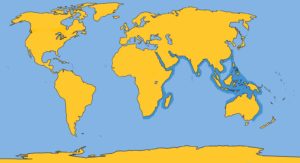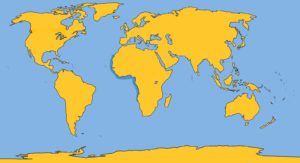Taxonomic Note: While these two animals are for the most part indistinguishable from each other, there are subtle morphological differences, such as skull shape and tooth count, that have many believing that they are two separate species.
ATLANTIC HUMPBACK DOLPHIN (scroll down for Indo-Pacific humpback dolphin)
Family: Delphinidae
Genus: Sousa
Species: S. teuszii (Kukenthal, 1892)
Not all cetaceans roam the open oceans; some, such as the Atlantic hump-back dolphin, prefer to inhabit a limited stretch of water. Although this species is known to live along the west coast of Africa, from Senegal to Cameron, little information has been gathered and few photographs taken. Until recently, this dolphin was known from a single damaged specimen found by a Mr. Teuz in 1892. Several more have been discovered near Dakar in recent years and researchers are assembling information on their life history. Although the animal is known as a hump-back dolphin, the nature of its hump —whether related to age, sex, or another factor — is unclear. Recent aerial observations have revealed that these dolphins use waves or strong swells to gain momentum in diving for food; dives may last for up to three minutes. Observations of older and larger adult animals show them to be heavily scarred on the flanks and dorsal regions. Young animals are unscarred and uniformly gray, giving them the nickname “graybacks”. Animals of all ages have been observed leaping clear of the water, sometimes performing somersaults. Rapid swimming and chasing were also evident.
Physical Description: Except for the narrower body and smaller flippers, they resemble bottlenose dolphins. The beak is well defined with a demarcation line the beak and a small melon. The blowhole projects up from the forehead, forming a small hump.
Color: Adults exhibit whitening of the dorsal fin and adjacent areas, extending occasionally from the tip of the rostrum to the flukes — this appears to be a phenomenon of increased age. The average animal is slate gray on the sides, paler gray ventrally.
Fins and Flukes: The dorsal fin rises gradually into a falcate fin. From information available, it appears the flippers are rounded at their edges. Flukes are thin, well developed, and pointed at the tips, with a slight median notch.
Length and Weight: Up to 9.25 ft (2.8 m) and 630 lb (290 kg).
Teeth: 26 to 31 per side are found in both upper and lower jaws, separated by spaces.
Feeding: Small fish, caught as the herd disperses in all directions.
Breathing and Diving: The dive lasts for at least 3 minutes.
Mating and Breeding: There appears to be no birthing season, although a peak of births is apparent in the summer months.
Herding: Atlantic hump-backed dolphins often are found individually or in pairs; groups of up to 20 are not uncommon.
Distribution: They are most common in waters near Senegal, especially Dakar, ranging to the Cameroons of the west coast of Africa. They were discovered in the harbor of Douala, Cameroon. Apparently they are restricted to coastal areas and river estuaries.
Migration: Apparently does not migrate.
Natural History Notes: These animals have been seen swimming with bottlenose dolphins.
INDO-PACIFIC HUMPBACK DOLPHIN
Family: Delphinidae
Genus: Sousa
Species: S. chinensis (Osbeck, 1765)
Like many other cetaceans, the Indo-Pacific hump-back dolphin is often seen but rarely studied in its native habitat. It lives in shallow waters near coasts and penetrates into estuaries. There have been reports that this species traverses mud banks. If so, it would be only the third cetacean known to remove itself from the water, the other two being the Amazon River dolphin and bottlenose dolphin. The claim is at least plausible since the animal’s ability to negotiate changing tidal depths is well known.
Physical Description: This animal superficially resembles the bottlenose dolphin but has a thinner beak and the shape of the dorsal fin varies with geographical distribution.
Color: These dolphins are ivory colored with a pink ventral region. The fins and flukes are a mixture of brown and pink.
Fins and Flukes: The triangular dorsal fin is rounded at the tip. The hump-and-fin dorsal fin (see Atlantic hump-backed dolphin) appears only on animals found west of Indonesia; animals found east of Indonesia have a simple dorsal fin. The flippers are small, paddle-shaped, and rounded at the tips, while the flukes are well developed, pointed at the tips, with a slight median notch.
Length and Weight: They reach 9.75 ft (3 m) in length and estimated 330 lb (150 kg).
Teeth: They possess 32 to 37 small, conical teeth in each side of the upper jaw; 32 to 34 in each side of the lower jaw.
Feeding: Their habits are little known. They appear to feed mostly on fish.
Breathing and Diving: Indo-Pacific hump-backed dolphins are slow swimmers, breathing every minute or so after rising to the surface at a steep angle, often exposing t he head and rostrum. When diving they arch their back dramatically.
Mating and Breeding: Newborns are 35.5 in (90 cm) and 55 lb (25 kg). Calves are born year round, with a peak in summer months.
Herding: They are found individually or in herds of up to 20, although six is the average number.
Distribution: Subpopulations are found in the coastal waters of the Indian and western Pacific oceans (Sousa plumbia), from Port Elizabeth, South Africa, north to the Red Sea (Sousa lentiginosa), and east to southern China, including the lower reaches of the Yangtze, Foochow, and Canton rivers; Borneo and northeastern and eastern Australia (Sousa borneensis).
Migration: No information available.
Natural History Notes: Often they are extremely active when on the surface, swimming on their sides, and young animals are known to leap from the water. They are found often with bottlenose dolphins and finless porpoises.
INDO-PACIFIC HUMP-BACKED DOLPHIN DISTRIBUTION
ATLANTIC HUMP-BACKED DOLPHIN DISTRIBUTION









